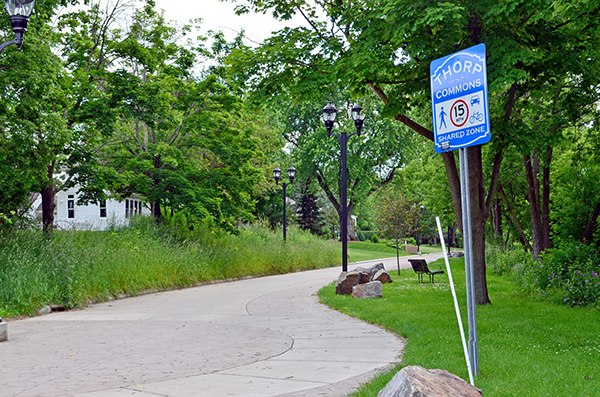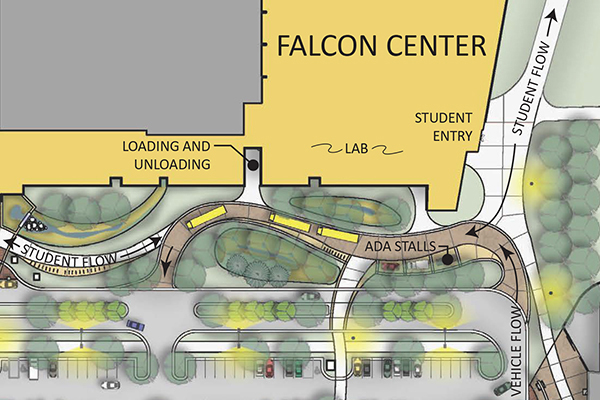Cities Find Shared-Use Streets Just Woonerf-ul
 A new old street design concept with a funny name is popping up in communities throughout the world. The woonerf (click here for pronunciation) is Dutch for “living street” and is reminiscent of an Old World village square. A woonerf-styled street is shared by cars, trucks, bikes, and people without the need for traffic lights, painted lines, and similar traffic control devices.
A new old street design concept with a funny name is popping up in communities throughout the world. The woonerf (click here for pronunciation) is Dutch for “living street” and is reminiscent of an Old World village square. A woonerf-styled street is shared by cars, trucks, bikes, and people without the need for traffic lights, painted lines, and similar traffic control devices.
The success of a woonerf depends on all street users becoming both more alert and more cooperative. Rather than seeing a street as the fastest connection between two places, drivers learn to expect the unexpected – a child playing in the street, neighbors chatting at the curb, bicyclists pedaling along – and thus slow down and focus on their surroundings. Residents along the woonerf also share in building this social contract with drivers by reclaiming their street – spending time in their front yards and connecting with their neighbors, allowing their children to walk to school, decreasing their own vehicle use by consolidating trips and walking or biking when possible.
The late Dutch engineer Hans Monderman is recognized for developing the “shared space” concept of urban design. He envisioned a “traffic world” and a “social world.” Highways and freeways are part of the traffic world and need traditional traffic engineering devices. But cities and villages are part of the social world, and as such motorists need to remember they are guests and should conduct themselves as such. One of Monderman’s primary “traffic control devices” in the social world of the city is eye contact, according to David Engwicht in “Mental Speed Bumps: The Smarter Way to Tame Traffic.”
Engwicht writes: “Signs and traffic control devices (including traffic calming devices) destroy the social context. (Monderman) argues that one of the strongest forms of communication in the social world is eye contact. To make motorists part of the social world, Hans believes his primary design challenge is to force motorists into eye contact with the other users of the space. Traffic control devices remove the need to make eye contact.”
Engwicht, known as the “guru of traffic calming,” has this to say about solving traffic problems: “The solution to traffic problems in neighborhoods is not more speed bumps. The solution is an outbreak of civility that slows our rampant individualism.”
Our streets and highways are part of the public realm and as such provide for more than just the movement of automobiles. Woonerfs can add to the quality of life and economic vitality of our communities. Woonerf applications need to consider adjacent land use context, traffic levels, and street network connectivity. Many woonerfs include some degree of traffic calming with surface treatments, roadway narrowings, curvilinear design treatments, and landscaping to provide a safe condition for all users of the public realm. A key element of safe woonerf design includes reduced speeds of around 15 mph.
Sure, you might say, woonerfs work in small villages in the Netherlands, but they’ll never work in our big American cities. And while it’s true that you can’t woonerf-ize a major highway, a number of metropolitan areas in the United States and around the world are giving woonerfs a try. Batavia, Illinois, a suburb of Chicago, built a woonerf to help revitalize its downtown. A 400-foot woonerf in Eau Claire, Wisconsin (pictured above), meanders between the Chippewa River and a block of stately homes near the University of Wisconsin-Eau Claire.
 A brand-new woonerf is also part of the University of Wisconsin-River Falls’ brand-new Falcon Center. When the facility opens this fall, students, staff, and visitors will likely first notice the expanded and improved athletic and recreational facilities inside and out. But pedestrians and bicyclists will also share access with team buses as they load and unload at the Falcon Center; Americans with Disabilities Act-compliant parking is also part of the woonerf. It’s a people-oriented space that allows vehicle circulation – and will likely require plenty of eye contact among pedestrians, bicyclists, and drivers as they negotiate the shared space. As shown in the accompanying rendering, the pavement color changes in the vehicle access area, alerting all who enter that there is something different about this area.
A brand-new woonerf is also part of the University of Wisconsin-River Falls’ brand-new Falcon Center. When the facility opens this fall, students, staff, and visitors will likely first notice the expanded and improved athletic and recreational facilities inside and out. But pedestrians and bicyclists will also share access with team buses as they load and unload at the Falcon Center; Americans with Disabilities Act-compliant parking is also part of the woonerf. It’s a people-oriented space that allows vehicle circulation – and will likely require plenty of eye contact among pedestrians, bicyclists, and drivers as they negotiate the shared space. As shown in the accompanying rendering, the pavement color changes in the vehicle access area, alerting all who enter that there is something different about this area.
The Village of Suamico in northeast Wisconsin is also considering a woonerf for the Vickery Village area of the community as part of the reconstruction of Riverside Drive. Vickery Village is located in what once was part of early Suamico’s business district. It now is a trendy area of restaurants and gift/arts shops.
Woonerfs are more costly than traditional streets because of their varied pavement treatments, pedestrian-scale lighting, and in some cases the increased use of bollards (short vertical posts to direct traffic). But they are another useful tool for urban planners and traffic engineers to consider as they develop livable communities and smart streets.
Interested in learning more? Contact traffic engineer Ken Voigt.

Post a comment: